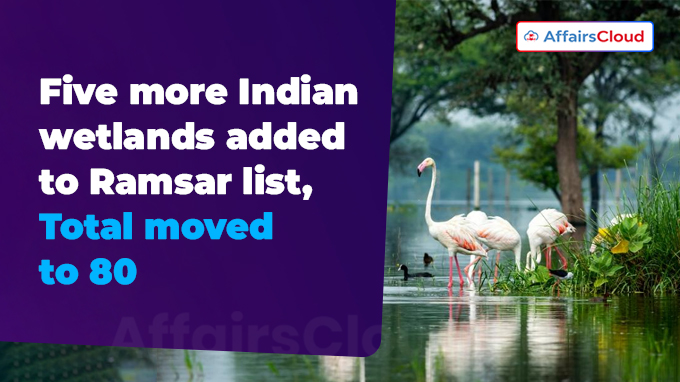 On 1st February 2024, Union Minister Bhupender Yadav, Ministry of Environment, Forest and Climate Change(MoEFCC) announced that 5 wetlands from India (3 from Karnataka and 2 from Tamil Nadu-TN) were designated as RAMSAR Sites – Wetlands of International importance.
On 1st February 2024, Union Minister Bhupender Yadav, Ministry of Environment, Forest and Climate Change(MoEFCC) announced that 5 wetlands from India (3 from Karnataka and 2 from Tamil Nadu-TN) were designated as RAMSAR Sites – Wetlands of International importance.
- With this addition, the total number of RAMSAR sites in India has increased from 75 to 80.
5 New RAMSAR sites
i.Magadi Kere Conservation Reserve; Ankasamudra Bird Conservation Reserve; and Aghanashini Estuary in Karnataka; and
ii.Karaivetti Bird Sanctuary; and Longwood Shola Reserve Forest in TN.
Note: On 31st January 2024, Dr Musonda Mumba, Secretary General of the Convention on Wetland(Ramsar Convention) handed over the certificates of these 5 sites, ahead of the World Wetlands Day 2024 which will be observed on 2nd February 2024.
Details of the 5 New Ramsar Site:
| Name of Wetland | Area (In Hectares) | Location |
|---|---|---|
| Ankasamudra Bird Conservation Reserve | 98.76 | Uttara Kannada, Karnataka |
| Aghanashini Estuary | 4801 | Bellary, Karnataka |
| Magadi Kere Conservation Reserve | 54.38 | Gadag, Karnataka |
| Karaivetti Bird sanctuary | 453.72 | Ariyalur, TN |
| Longwood Shola Reserve Forest | 116.007 | Kotagiri, TN |
| Total Area of 5 Wetlands | 5,523.867 |
Ankasamudra Bird Conservation Reserve:
It is a humanmade Village Irrigation Tank that spans 98.76 ha (244.04 acres) adjacent to the Ankasamudra village.
ii.It is an ecologically important wetland, rich in biodiversity, with over 210 species of plants; 8 mammal species; 25 reptile species; 240 bird species; 41 fish species; 3 frog species; 27 butterfly species; and 32 odonate species.
iii.Over 30,000 waterbirds nest and roost at this wetland, which is home to over 1% of the biogeographic population of Painted Stork and Black-headed Ibis.
Aghanashini Estuary:
i.It spreads over an area of 4801 ha and emerges at the intersection of the Aghanashini River with the Arabian Sea.
ii.The wetland also provides livelihoods to 6000-7500 families through diverse activities including fishing, agriculture, etc.
iii.The mangroves lining the estuary help to protect the shores against storms and cyclones.
iv.The estuary supports over 66 waterbird species and over 1% of the biogeographic population of 15 waterbird species.
Magadi Kere Conservation Reserve:
i.It is a human-made wetland that spans nearly 50 ha and was constructed to store rainwater for irrigation purposes.
ii.It is home to over 166 species of birds, of which 130 are migratory.
iii.The wetland harbours 2 vulnerable species: Common pochard and River tern (Sterna aurantia); and 4 near-threatened species: Oriental Darter, Black-headed Ibis, Woolly-necked Stork, and Painted Stork.
iv.It is also one of the largest wintering grounds for the Bar-headed goose in Southern India, and nearly 8,000 birds visit the site during winter.
v.The wetland is a designated Important Bird Area (IBA) and is also listed as a priority area for conservation in India.
Karaivetti Bird Sanctuary:
i.It spans 453.72 ha and is one of the largest inland wetlands of Tamil Nadu. It is a significant source of groundwater recharge for the area.
ii.It hosts one of the largest congregations of waterbirds in Tamil Nadu, recorded the presence of about 198 species of birds.
Longwood Shola Reserve Forest:
i.It derives its name from the Tamil word, “Solai”, which means a ‘tropical rain forest’.
ii.The ‘Sholas’ are found in the upper reaches of the Nilgiris, Anamalais, Palni hills, Kalakadu, Mundanthurai, and Kanyakumari in Tamil Nadu.
iii.As many as 14 out of 26 endemic bird species of the Western Ghats are found in these wetlands.
Key Points:
With the addition of these 5 wetlands, the total area covered under Ramsar sites is now 1.33 million hectares (ha) which is an increase of 5,523.87 ha from the existing area of 1.327 million ha.
The total number of RAMSAR sites in TN has increased to 16. TN tops the list of states with maximum number of RAMSAR sites followed by Uttar Prades (10 sites).
Note: Keoladeo National Park (Rajasthan) and Chilika Lake (Odisha) were the first 2 sites to be placed on the “Ramsar List” by the Government of India in 1981.
Ramsar Convention:
Convention on Wetlands or Ramsar Convention on Wetlands of International Importance was adopted in the Iranian city of Ramsar on February 2, 1971 and came into force in 1975.
- India ratified this Convention on 1st February 1982.
RAMSAR site:
A Ramsar site is a wetland site of international importance in conserving biological diversity, especially those providing waterfowl habitat.under the Ramsar Convention
Recent related News:
The Ministry of Environment, Forest and Climate Change (MoEF&CC) launched 2 new initiatives, the Green Credit Program (GCP) and the Ecomark Scheme to encourage sustainable practices rooted in tradition and conservation and promote the ideas of ‘LiFE’- ‘Lifestyle for Environment’ movement.
About Ministry of Environment, Forest and Climate Change (MoEF&CC):
Union Minister– Bhupender Yadav (Rajya Sabha- Rajasthan)
Minister of State– Ashwini Kumar Choubey (Constituency- Buxar, Bihar)




